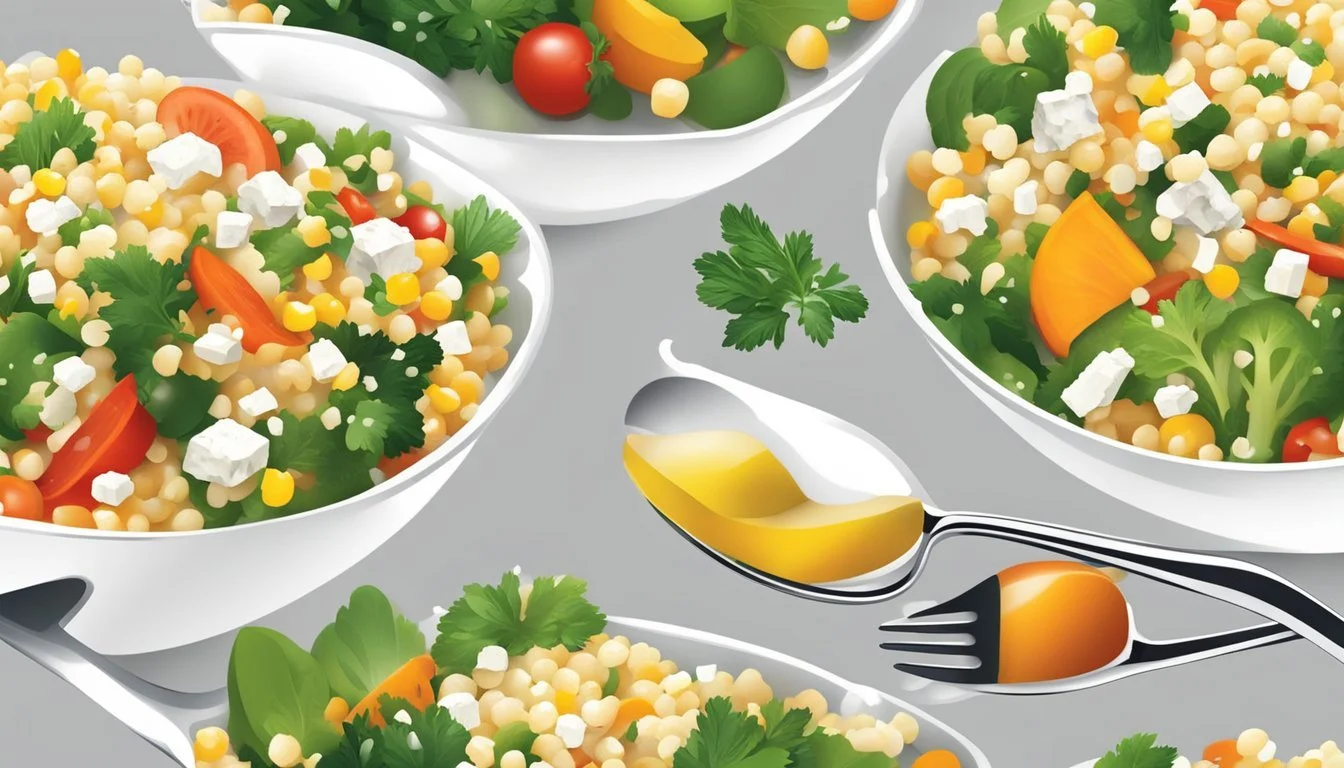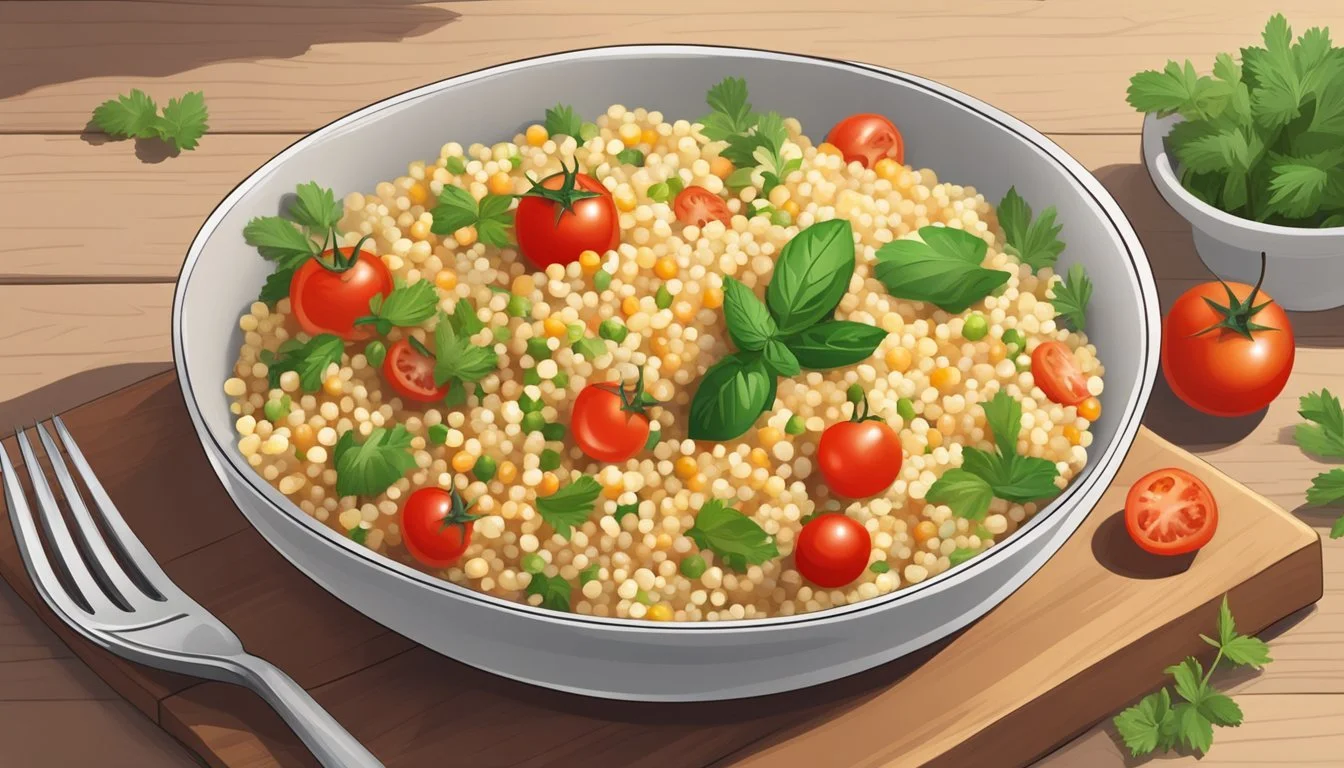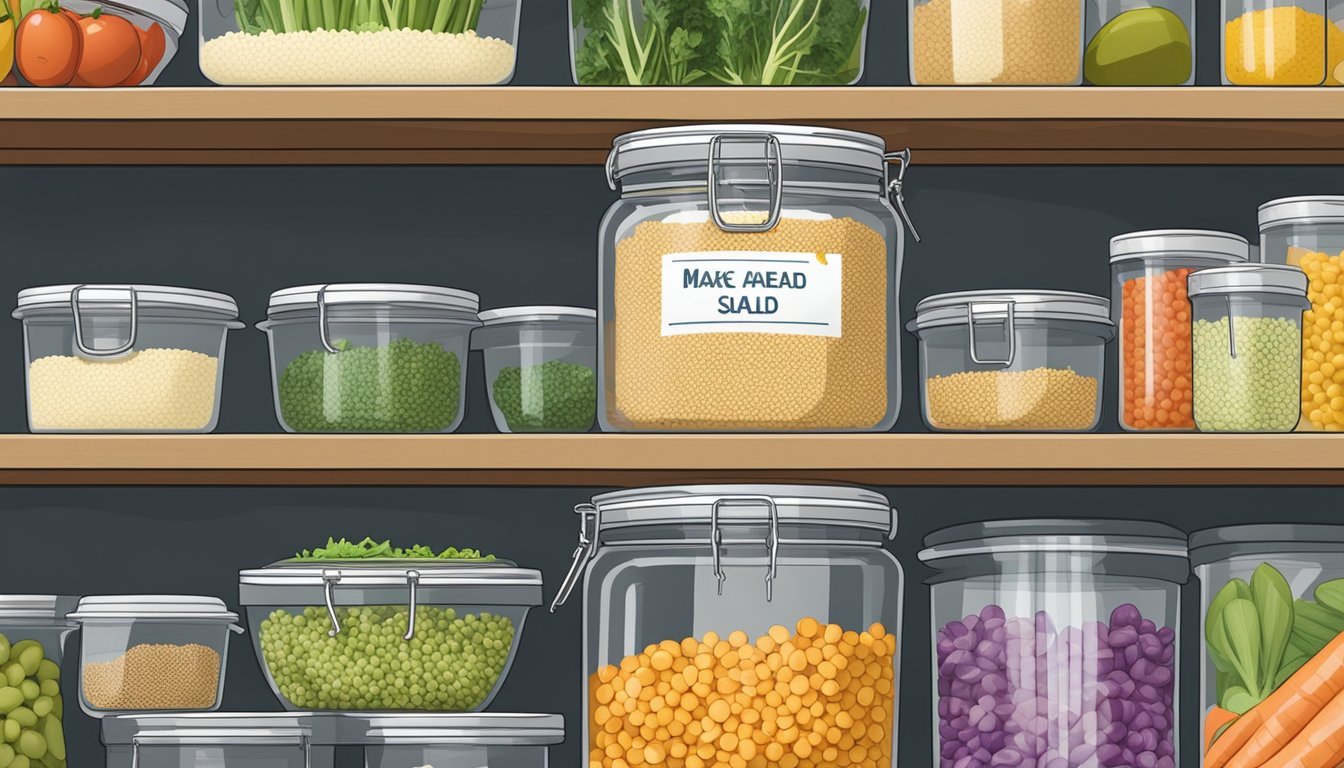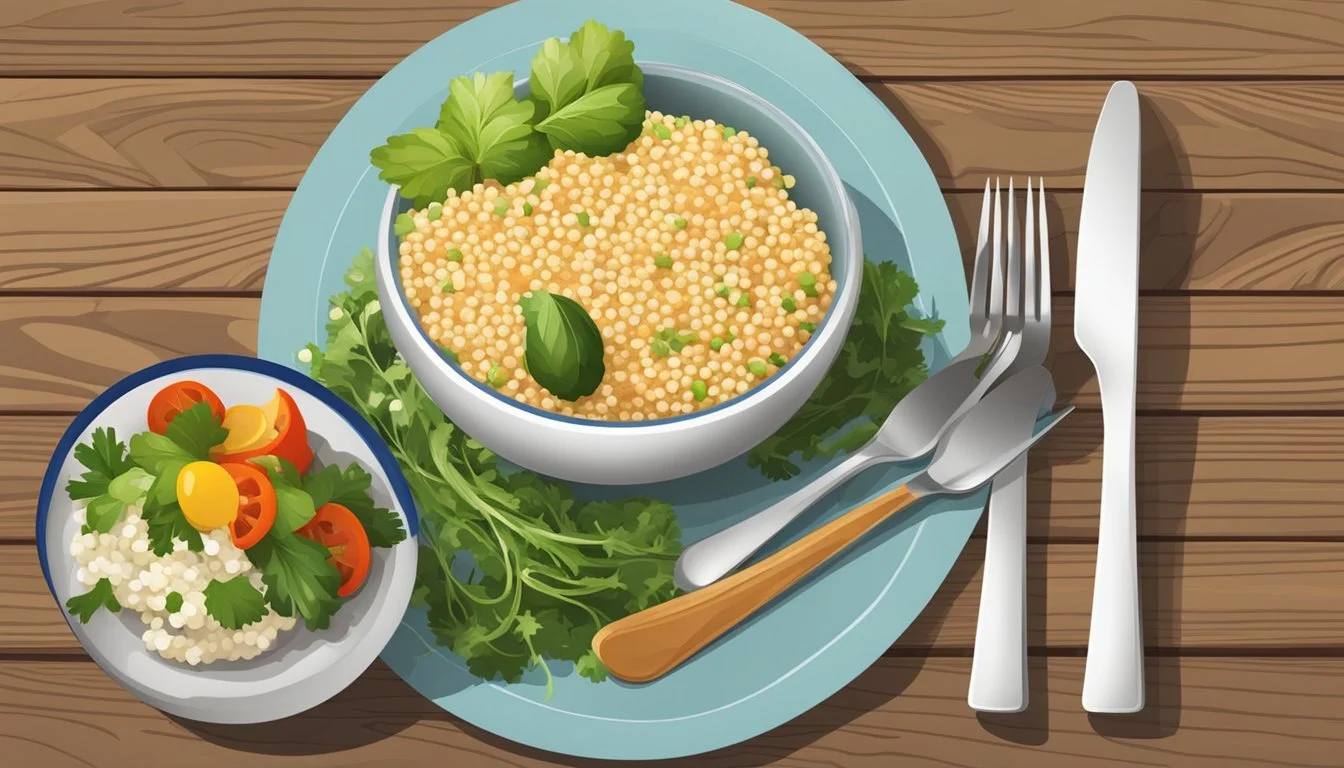How do you eat an Israeli couscous salad?
Your Guide to Enjoying this Mediterranean Delight
Israeli couscous (What wine goes well with couscous?), also known as Pearl couscous or Ptitim, stands out in the world of grains for its versatility and satisfying texture. Originating in the Middle East, this pasta-like ingredient made from semolina or wheat flour has gained popularity worldwide. When it comes to enjoying Israeli couscous, an Israeli couscous salad is a delightful dish that can be served warm or at room temperature, making it a perfect addition to any meal, picnic, or potluck.
The salad amalgamates the chewy pearls of couscous with a colorful medley of vegetables, legumes, and often a tangy dressing. To enhance its nutritional profile, one might include ingredients like chickpeas for protein, a variety of fresh vegetables for vitamins and minerals, and a vinaigrette based on olive oil for healthy fats. The amalgam of textures and flavors not only provides a gastronomic pleasure but also contributes to a well-balanced diet.
When eating an Israeli couscous salad, diners typically encounter a harmonious balance of savory notes from the couscous, which has been toasted to a golden hue, and the freshness of herbs and vegetables. The method of preparation, which usually involves simmering the couscous in water or broth until it becomes tender yet firm to the bite, allows for the grains to absorb the surrounding flavors effectively. This dish's adaptability allows it to be customized to personal preferences or dietary requirements, ensuring its place at the table regardless of the dining occasion.
Ingredients Overview
Israeli couscous salad merges the texture of pasta with the fresh flavor profile of Mediterranean herbs and vegetables. It's a harmonious dish where each ingredient plays a critical role, offering a satisfying combination of carbohydrates, proteins, and fiber.
Key Ingredients
Israeli Couscous/Pearl Couscous: The base of the salad, these small, pearl-shaped pasta pieces provide a satisfying chewiness and are adept at absorbing dressings and flavors.
Tomatoes/Cherry Tomatoes: Add a juicy, sweet, and slightly acidic taste which complements the starchiness of the couscous.
Cucumbers: Offer a crunchy texture and refreshing flavor, acting as a palate cleanser.
Fresh Herbs (Parsley, Mint, Chives): Essential for a burst of freshness, herbs enhance the dish with aromatic flavors.
Feta Cheese: Brings a tangy, salty dimension that balances the fresh ingredients.
Olives: Give a briny depth to the overall taste.
Green Onions/Red Onion: Provide a sharp, pungent element that contrasts well with the other flavors.
Additional Elements
Dressing (Extra Virgin Olive Oil, Lemon Juice, Garlic): The cornerstone to any salad that elevates the overall taste. A classic lemon dressing with olive oil adds brightness and ties the salad together.
Additional Vegetables (Red Onion, Cucumber): These can vary but commonly include items that contribute additional crunch and flavor.
Additional Proteins (Chickpeas): Sometimes included to make the salad more filling, chickpeas offer protein and fiber.
By carefully selecting each component, the consumer is ensured a well-rounded experience both in nutrition and taste, making Israeli couscous salad not just a side dish but a potential main course as well.
Preparation Guidelines
The creation of an Israeli couscous salad involves two primary steps: cooking the pearl couscous to perfection and then combining it with fresh ingredients and a flavorful dressing.
Cooking Couscous
To cook Israeli couscous, one starts by measuring the correct amount of water—usually around 1.5 to 1.75 cups for every cup of couscous. The couscous is first toasted in a dry pot or one with a little oil to enhance its nutty flavor, stirring frequently. After achieving a light, golden color, boiling water is added, and then the couscous is seasoned with kosher salt to taste. The heat on the stove is then lowered to achieve a gentle simmer. The pot is covered, and the couscous cooks until it absorbs the water, typically within 10 to 14 minutes. Once done, the couscous is taken off the heat and left covered for a few minutes, then fluffed with a fork to separate the grains.
Combining Ingredients
Once the couscous is cooled, the salad assembly begins. Priority is given to freshness and vibrancy, with ingredients like diced tomatoes, finely chopped onions, and other desired vegetables being prepared. The aim is to cut these components uniformly for a harmonious texture and appearance. For added flavor, they can sprinkle salt and pepper, to taste, over the vegetables. A dressing, often a blend of olive oil, lemon juice, honey, and dijon mustard, is whisked until smooth and then poured over the mixture. The final step is to fold everything gently together, ensuring the couscous and vegetables are well coated with the dressing, allowing for an even distribution of flavors throughout the Israeli couscous salad.
Flavor Enhancement
Israeli couscous salad, with its versatile nature, becomes a canvas for a myriad of flavor possibilities. Key elements such as fresh herbs, aromatic spices, and a harmonious balance in dressings significantly elevate the taste experience of the dish.
Herbs and Spices
The judicious use of herbs and spices directly influences the aroma and savor of Israeli couscous salad. Incorporating fresh herbs like dill (how long does dill last?) and basil can impart a vibrant and refreshing taste. For a zesty kick, freshly squeezed lemon juice adds a citrusy dimension that complements the neutral taste of the couscous.
Fresh Herbs:
Dill: Provides a mild and slightly grassy flavor.
Basil: Introduces a sweet and peppery taste.
To enhance the overall depth, a pinch of kosher salt and a crackling of black pepper adjust the seasoning to perfection, bringing out the full spectrum of flavors prevalent in the accompanying ingredients.
Dressing Variations
The role of a dressing is paramount, as it binds all components together while contributing pivotal flavors. For a classic approach, a dressing made with extra-virgin olive oil and fresh lemon juice serves as a simple yet effective combination. Yet, variations exist that can suit a range of palates:
Balsamic Vinaigrette:
3 parts olive oil
1 part balsamic vinegar
A dash of kosher salt and black pepper
Lemon Mustard Dressing:
4 tablespoons olive oil
2 tablespoons lemon juice
1 teaspoon dijon mustard
Salt and pepper, to taste
Whether opting for the acidity of vinegar or the complexity of dijon mustard, these dressings should be whisked until smooth and then drizzled over the salad just before serving. Use them to introduce new character and zest, ensuring that the couscous is well-coated for an evenly distributed flavor.
Nutritional Information
Israeli couscous salad can be a nutritious addition to any meal, whether served as a side dish or a main course. It offers a balance of carbohydrates, proteins, and essential nutrients, fitting well into both vegetarian and vegan diets.
Health Benefits
Israeli couscous, also known as pearl couscous, is a small, wheat-based pasta that provides a good source of energy. When combined with vegetables, herbs, and a light dressing, as is typical in salads (What wine goes well with salads?), it elevates the dish's fiber and vitamin content. Fiber is critical for digestive health and can help regulate blood sugar levels.
Fiber: Contributes to digestive health and satiety
Protein: Supports muscle repair and growth; present in the dish when chickpeas or feta cheese are added
Vitamins and Minerals: A variety of vegetables like bell peppers, cucumbers, and tomatoes can offer vitamins A and C, as well as potassium and iron
Dietary Considerations
An Israeli couscous salad is not only flavorful but also flexible, able to accommodate various dietary requirements.
Calories: It can be relatively low in calories, especially when dressed with citrus-based dressings instead of creamy alternatives.
Fat: Olive oil is a common ingredient in dressings, which provides heart-healthy monounsaturated fats.
Sodium: While couscous itself is low in sodium, the overall sodium content can be controlled by moderating the addition of salt and cheese.
Vegetarian/Vegan Options: It can be easily adapted for vegetarian and vegan diets by omitting animal products and ensuring the dressing is free from honey or dairy.
For those looking to maintain a balanced diet, this dish can play a part due to its adjustable ingredients and overall nutrient profile.
Serving Suggestions
Israeli couscous salad is a versatile dish that can be customized to suit various tastes and dining occasions. It serves well as a refreshing side or a light main course, enriched by its Mediterranean flavors and the ability to pair with numerous dishes.
Accompanying Dishes
Israeli couscous salad complements a variety of sides. For a Mediterranean-inspired meal, pair it with:
Greek Salad: A blend of juicy grape tomatoes, crisp cucumbers, and tangy feta cheese.
Panzanella: This traditional Italian bread salad adds a robust texture contrast.
Arugula Salad: Its peppery leaves elevate the couscous salad's flavor profile.
Meal Pairings
As either a side or a main, Israeli couscous salad pairs well with proteins for lunch or dinner:
Chicken: Grilled or roasted chicken (What wine goes well with roasted chicken?) breast slices atop the salad for a hearty meal.
Steak: A succulent, sliced steak adds richness to the light couscous.
Salmon: Flaky salmon fillets bring omega-3s and a delicate taste to the pairing.
Presentation Tips
Enhance the dining experience with these presentation tips:
Plating: Serve the salad in a large, shallow bowl to showcase the medley of colors.
Garnish: A sprinkle of feta cheese and finely chopped parsley add visual appeal and bursts of flavor.
Textures: Include a variety of textures, like crunchy bell pepper and soft grape tomatoes, to create a more engaging mouthfeel.
Storage and Make-Ahead Tips
When it comes to enjoying Israeli couscous salad at its best, proper storage is key to maintaining freshness, while making components in advance can simplify meal prep. Here's how one can manage both.
Refrigeration and Shelf Life
Once prepared, Israeli couscous salad should be stored in the refrigerator to preserve its taste and texture. The salad should be placed in an airtight container to prevent it from absorbing other flavors and odors. Typically, the salad will keep well for 2-3 days, though one should check for signs of spoilage—such as a sour smell or slimy vegetables—before eating.
Fresh Ingredients like tomatoes may release moisture over time, potentially making the salad soggy.
Dressing Separate: One can refrigerate the dressing separately to prevent the couscous from becoming too soft.
Prep in Advance
Making Israeli couscous salad ahead of time can expedite putting together a quick side dish. The couscous itself can be cooked, cooled, and then stored in the fridge up to two days in advance. If one is aiming for a fresher salad, they should consider adding certain ingredients like chopped herbs or diced vegetables on the day it will be served.
Couscous: Cook, cool, and store in the fridge.
Vegetables/Herbs: Chop and keep in a separate container in the fridge.
By following these tips, one can ensure that their Israeli couscous salad remains delicious and that components are ready when needed.
Culinary Variations and Alternatives
Israeli couscous salad offers a versatile canvas for a variety of ingredients, allowing one to craft a dish that caters to personal preferences or dietary needs. Fresh produce and lean proteins can elevate the nutritional profile, while nuts and seeds can contribute a satisfying crunch.
Vegetable Inclusions
For a nutrient-rich salad, one can incorporate a colorful medley of vegetables. Common choices include:
Cucumbers: Sliced or diced for a refreshing crispness.
Grape Tomatoes: Halved to add a juicy, sweet burst.
Bell Peppers: Finely chopped, they introduce a mild, sweet flavor and crunch.
Red Onions: Thinly sliced for a sharp, piquant edge.
Each vegetable not only adds a burst of color and texture but also enhances the salad’s overall nutritional value.
Protein Additions
Introducing proteins to Israeli couscous salad transforms it from a side dish into a hearty main course.
Chicken: Grilled or roasted chicken breast, cubed or shredded, provides a lean, high-quality protein option.
Shrimp: Cooked shrimp can lend a delicate, seafood twist to the salad.
Chickpeas: For a plant-based protein source, chickpeas are a flavorful and filling choice.
To complete the dish, one can sprinkle over a selection of nuts such as almonds or walnuts, or seeds such as pumpkin or sunflower, adding a textural contrast and richness.
Pairing the Right Utensils
For the perfect Israeli couscous salad experience, selecting appropriate utensils for serving and preparation ensures both ease and enjoyment.
Serving Tools
The ideal serving tools for Israeli couscous salad are ones that accommodate its unique texture and mixed ingredients. One should opt for:
Serving Spoon: A large, preferably slotted, serving spoon allows for scooping the couscous along with any dressing or larger mix-ins.
Salad Tongs: For more composed salads, tongs can help grab a well-mixed bite, combining the pearl couscous with other ingredients.
Preparation Equipment
Preparing Israeli couscous salad requires specific equipment to ensure the grains are cooked perfectly and the salad components are prepared with precision.
Saucepan: A medium-sized saucepan with a well-fitting lid is essential for cooking the couscous to the point where it's tender but still maintains its shape.
Strainer: A fine-mesh strainer is useful to drain any excess liquid after the couscous is cooked.
Mixing Bowls: A set of mixing bowls in various sizes allows for efficient mixing of the couscous with dressings and other salad ingredients.
Salad Spinner: In case leafy greens are a part of the salad, a salad spinner ensures they are clean and dry.
Knife and Cutting Board: A sharp knife and a sturdy cutting board are necessary for chopping vegetables or any additional toppings for the salad.
Exploring Other Couscous Types
When considering the incorporation of Israeli couscous into a salad, it's essential to recognize how it stands in comparison to other grains and its adaptability in various cuisines. This granular pasta made from semolina flour offers a unique texture and has distinct nutritional profiles compared to other popular grains.
Comparison to Other Grains
Israeli couscous, or pearl couscous, has a larger, round shape that provides a chewy texture, setting it apart from traditional couscous. Traditional couscous is smaller in size and lighter in texture, often used in North African dishes. Compared to rice, Israeli couscous is similar in caloric and carbohydrate content, but typically offers a more satisfying bite with its larger pearls. Quinoa, another grain alternative, offers a higher protein and fiber content but has a softer, fluffier texture when cooked. In contrast to orzo, a rice-shaped pasta, Israeli couscous maintains a more consistent, spherical shape and usually takes slightly longer to cook.
Using Alternatives
While Israeli couscous pairs well with vegetables and dressings for a pearl couscous salad, it can be substituted with other grains for texture or dietary preferences. Bulgur, for example, can be used for a nutty flavor and a quicker preparation time. It absorbs dressings well, making it suitable for a variety of Mediterranean dishes. Pasta salad often features orzo as a base, but substituting with Israeli couscous can create an interesting twist in both texture and flavor.
Beyond Mediterranean Cuisine
Although commonly associated with Mediterranean cuisine, Israeli couscous is versatile and can be integrated into an array of global dishes. It’s an excellent base for a variety of flavors, including creamy sauces, vinaigrettes, or robust spices. Its adaptability means that it can also step in as a satisfying addition to soups or stews, where it tends to absorb the surrounding flavors while maintaining its distinct texture.
Nutritional Differences
Israeli couscous, being made from semolina flour, offers a substantial amount of carbohydrates but is not particularly high in fiber. For those keeping a close watch on their diets, it's important to note the nutritional value per serving: calories typically range from 200 to 250, protein about 6 to 9 grams, and fat content is low, while sodium varies depending on preparation. For a fiber boost, one might opt for quinoa or bulgur as alternatives, which also provide a similar satiety to that of a hearty Israeli couscous salad.









